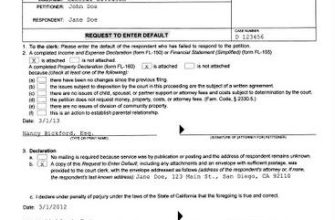It is possible to obtain the divorce records of your spouse by contacting multiple counties. If you do not have the address of your spouse, you can still contact the county sheriff’s office. The sheriff’s office serves as the process server for legal documents. Whether your spouse is local or not, he may have sent the documents to the sheriff to obtain it. Sheriff service is inexpensive and easy to arrange.
- How to get a divorce without a spouse’s consent
- Requirements for getting a divorce
- Requirements for obtaining a divorce decree
- Finding divorce records online
- Uncontested divorces can take anywhere from two days to 18 months
- Contested divorces can take longer than uncontested divorces
- Mediation and arbitration can lengthen the process
- California’s «cooling-off period» is not the longest wait time required in a state for processing a divorce
How to get a divorce without a spouse’s consent
If you have filed for divorce, but you cannot obtain the consent of your spouse, the process will proceed automatically. First, your spouse must accept the divorce papers you served. Whether he or she signed the Acknowledgement of Service form or not, the spouse must acknowledge receipt of the divorce papers. Then, the divorce will begin, and the process will proceed with custody and property division requests.
Once you’ve filed for divorce, the court will need to be satisfied that you made reasonable efforts to locate your spouse and that you made detailed records. If your spouse is not available, it will be difficult to get a divorce without their consent. However, if you have good reasons for requesting a divorce, this process can be a bit more straightforward. It may not be as painful as you think, and it can be done in just a few days.
Although you must notify your spouse in writing, you can still get a divorce if you can’t find your spouse. In some states, you can still serve your spouse without his or her consent. Just make sure that you save copies of every letter and undeliverable mail you send. But, in the end, the only way to prove your case is to provide evidence of your reasonable efforts.
Although getting a divorce without your spouse’s consent isn’t easy, you can still obtain one. In some states, it is possible to get a divorce without a spouse’s consent. However, you’ll need to follow certain rules and consult with a family law attorney. You need to be aware that the rules of the court differ from state to state, so make sure to speak to one of them if you’re unsure of the laws in your state.
Filing for a divorce without your spouse’s consent may seem impossible in some states. However, you can still file for divorce in many states. The process will differ, but in general, divorce petitions filed without your spouse’s consent will go through a default divorce process. In most states, divorce proceedings will be uncontested, meaning that the judge will likely dismiss your petition without hearing it.
Requirements for getting a divorce
Filing for a divorce does not necessarily mean your husband has already filed for it. It just means that you should do all the necessary steps in order to start the divorce process. If your husband filed first, you have to wait at least 20 days before filing your response. You need to prepare your financial records, account numbers, and evidence for the custody battle. You can hire a process server or a relative to serve the papers. Make sure you serve the papers properly or else your divorce will be declared invalid.
First, you must obtain a copy of the Complaint for Divorce from your husband. It should clearly state your demands for a divorce. Don’t overdo it; divorce is a negotiation process, so you don’t want to ask for too much in your Complaint. Otherwise, your husband may overreact and refuse to negotiate. Be prepared to provide additional information if necessary.
It is also important to establish credit before filing for divorce. If you have a credit card, you should apply for it in your name only. However, make sure to make all payments on time. It can take months to complete the divorce process, so even one late payment could cause damage to your credit. Make sure to keep up with your minimum payments on all your accounts, even if they are small.
In California, you can only file a divorce if one of you files for divorce. This is called a Petition, and the Petitioner’s intention is to dissolve the marriage. To respond to a divorce, you must file an FL-120 response. While responding does not mean that you agree with the petition, it allows the judge to hear your side of the story. Moreover, it protects your legal rights.

Before filing for a divorce, you should make sure that both you and your husband have lived separate lives for at least a year. This is necessary to establish a safe space for yourself and your children. If you cannot live separate and apart, you may want to consider hiring a lawyer. You will have to live separately for at least a year after the separation agreement.
Requirements for obtaining a divorce decree
You need to file all the necessary paperwork for a divorce in order to finalize the situation. The first step is to fill out the Notice of Entry of Order. This serves as your final Decree and triggers all of the deadlines and procedures you need to follow. You can also file this document by mail or e-filing it online. After you have filed your papers, the next step is to serve your husband with the Notice of Entry of Order.
The decree will include your husband’s financial obligations. You’ll be required to pay spousal support, child support, and any marital debt. If you have children, the decree will likely include the names of the parents. If you’ve filed for divorce, you need to obtain copies of all these documents. You’ll need proof of your income, assets, and any debt that you share.
A pre-trial hearing is another step in the divorce process. During this hearing, both parties must fill out detailed financial information. You must carefully consider your finances and complete all forms honestly. Inaccurate information could complicate the process. Make sure you gather all the necessary information in advance. You can even hire a mediator to help you with the paperwork. The court will let you know when the next hearing will take place. You may need to go to court a few times, depending on the amount of information you need to present.
Filing for a divorce is a complex process. You must be prepared to deal with the paperwork involved. The first step is to purchase an Index Number. You must then file the Summons with Notice or Verified Complaint. Make sure that you serve the other party with these papers. Then, read the Uncontested Divorce Forms Packet Instructions carefully to learn about the filing process.
Depending on the grounds, you may want to negotiate a separation agreement before you go to court. Usually, you have 20 days to file your Answers. You can hire a lawyer to assist you. If you cannot afford the costs of a divorce lawyer, your husband can request that you pay for the attorney’s fees. If your husband files for divorce before this date, you can still work out an agreement to end the divorce.
Finding divorce records online
If your husband filed for a divorce, you can find the details of the court proceedings in your state by searching divorce records online. There are many websites that offer these records for free. The only downside is that you may have to pay to see the actual divorce records. To avoid the hassle, you can try to find these records for free by following the steps outlined in this article. After all, the more information you have, the more accurate the results will be.
To find a divorce record, you will need to know the full name and last name of your husband and wife. In some jurisdictions, you will also need the city they lived in and the date they filed for divorce. The websites usually have instructions on how to proceed. Alternatively, you can try to contact the Department of Vital Records or your husband’s previous address. However, these two methods are not ideal as these services may not be free.
While it may seem impossible, divorce records are generally available to the public. However, in some cases, divorce records may be sealed due to extenuating circumstances. These cases may be very high-profile or contain child abuse. If you want to get a copy of the court records, you will need to get a court order and a certified copy of the divorce decree. The documents will have the date of the divorce and the names of both parties. Ultimately, you can find the information you need in your husband’s divorce records by searching online.
If your husband filed for a divorce in New York, it will be difficult to find the records of the court proceedings. While these records are public, they are not as accessible as the records of other states. Some states have very strict laws regarding this information. These laws apply to news media outlets, corporations, and professional organizations. In addition to finding divorce records online, you can also obtain your husband’s marriage license and divorce decree from the Circuit Clerk’s office.

The time it takes to finalize a divorce depends on the complexity of the case. Some cases take only a few days while others may take months or even years. Divorces with high property values or difficult custody issues tend to take longer. In these cases, mediation or arbitration may be necessary. Even California’s «cooling off» period isn’t the longest time to process a divorce in the state.
Uncontested divorces can take anywhere from two days to 18 months
An uncontested divorce is a divorce in which the parties agree that the marriage is over and want to dissolve the relationship. If both parties want a divorce, they can use a DIY Uncontested Divorce Program. Once they have agreed on the terms, they must serve the other party, which entails serving the defendant with the divorce papers and all of the relevant paperwork. Once served, the process may take anywhere from two days to 18 months.
In a typical uncontested divorce, there are no disputed issues or a high conflict over property and assets. Usually, the parties agree on the final distribution of the property, but there may be a dispute over retirement accounts, investment assets, or other significant items. This can lead to lengthy court proceedings. If your spouse isn’t cooperative during the divorce process, the divorce will take two days to 18 months.
When couples agree on a final settlement, an uncontested divorce is the fastest route to finalization. It can save a lot of money and time, but it can take a long time. The length of an uncontested divorce will depend on the state in which the couple lives. In some states, couples can finalize their divorce in as little as two days. In other states, the process may take as long as 18 months.
The process starts by filing the complaint with the court. In Florida, both parties must attend a parenting class and provide financial documents to the court. After service, the other spouse has 35 days to respond. After the service of the divorce complaint, the judge will decide if the couple has reached a settlement agreement. If both parties agree, the divorce can be finalized in as little as 30 days.
Depending on the circumstances, an uncontested divorce can take anywhere from two days to eighteen months. The time span can depend on many factors, but there are some factors that will make the process go more quickly or more slowly than others. One of the biggest factors is whether or not the parties are able to agree on every issue. If they cannot agree on every issue, an uncontested divorce can take two days to 18 months.
Contested divorces can take longer than uncontested divorces
If your spouse refuses to agree to terms of a divorce, a contested divorce will require a lengthy legal process. The court calendar, county in which you file, and cooperation between the spouses can all influence the timeline for a contested divorce. Besides that, contested divorces can be more stressful and require more paperwork. In addition, they can result in an appeal. Listed below are the common reasons why contested divorces take longer.
The first reason why contested divorces take longer is because a spouse who is not agreeable with the terms of the divorce must go to court to resolve the disagreement. This takes time because both spouses will have to conduct discovery. Discovery is the legal process of gathering relevant evidence. A spouse who believes that their spouse has hidden assets can serve their spouse with discovery and subpoenas and make them produce this evidence.
Uncontested divorces are often cheaper than contested divorces. When both spouses agree on the terms of a divorce, an uncontested divorce will take less time than a contested one. It can also result in less stress and legal fees. Unlike contested divorces, an uncontested divorce also preserves the relationship between spouses. In addition, uncontested divorces are also easier to obtain than contested ones.
An uncontested divorce usually takes less than three months. But every divorce case is different, and the length of time will vary based on many factors. A busy court and slow spouses can increase the waiting time. So, it is important to understand the process before beginning a contested divorce. So, how can you tell if a divorce will take longer than an uncontested one? A divorce attorney can help you determine the best course of action and avoid any unpleasant surprises in the process.

In a contested divorce, the parties cannot agree on anything related to the divorce. There is disagreement about the asset and property division, spousal support, and other issues. If you and your spouse are unable to reach a mutual agreement, a contested divorce will require a lengthy and expensive trial. However, if you are able to reach an agreement, you can still get a divorce and avoid the need to go to court.
Mediation and arbitration can lengthen the process
A dispute can be resolved in two ways: by negotiation or through litigation. Mediation helps the disputants resolve their differences through discussion, rather than through litigation. Because the parties are able to discuss their differences, the process promotes a better understanding of what each party did and why. This, in turn, can increase their desire to resolve the dispute. It also saves time and money. A divorce mediator can expedite the process significantly.
The duration of a mediation or arbitration process will vary based on the complexity of the case and the ability of the parties to reach a fair settlement. Generally, a mediation case lasts between three and four two-hour sessions spread over a month or two. More complex cases may take four to six months to complete. Both options have their benefits and drawbacks. If you are interested in mediation, it might be the way to go.
Arbitration is a legal method where both parties make their case before a neutral third party. It can be more formal than mediation, but the process remains judicial. The parties select the arbitrator, who may specialize in a particular area of divorce law. A contract can grant the arbitrator the power to decide issues related to the divorce. The process usually takes about a month, and the decisions are binding.
A successful mediation requires a careful consideration of your goals. Identify the «why» of your goals. If you have children, you may need to compromise to achieve your goals. Consider whether or not you can reach an agreement on child custody. If the outcome is the same as your expectations, mediation may be a better choice. If you are considering mediation, consider these tips:
There are some benefits to both methods, and each has its advantages and disadvantages. However, they both prolong the divorce process. One disadvantage of mediation is that it requires both parties to participate. In mediation, both parties should hire separate attorneys. During scheduled mediation meetings and one-on-one appointments, the attorneys will discuss and review any agreement the two parties have reached. The mediator serves as a neutral third party, who encourages open communication and helps the parties reach agreements.
California’s «cooling-off period» is not the longest wait time required in a state for processing a divorce
Many states have a required waiting period before filing for divorce, but California’s is the shortest. In contrast, many states require a certain amount of residency before filing. In addition, Arkansas has a mandatory 18-month separation period before a divorce can be finalized. If one of the spouses cohabits during that time, the clock resets.
A cooling-off period is the time period required for a divorce to be final. In California, this period lasts six months plus one day. However, the wait time can be shorter in other states, including Nevada and Pennsylvania. Idaho’s cooling-off period is 20 days, but it is extended to 90 days if there are children involved. Other states do not require a cooling-off period.
Couples who file for divorce in California must first go through a six-month cooling-off period. This time was originally set up to give couples a last chance to reconcile, but it has turned out to be a mere waiting period until a couple becomes unmarried. During this time, the couple can work out the details of the divorce, if necessary.
The duration of a divorce case depends on the complexity of the case, and whether or not both spouses are in agreement on all issues. If the spouses are in agreement, it can be as short as 20 days or even as long as 60 days before a final divorce is final. However, the non-filing spouse can reduce the duration of the answer period by hiring an attorney and filing the right documents early.
While there are many similarities between the states, the costs and duration of the divorce process are different. Different states require different amounts of time to process a divorce case, and filing fees vary widely. If you decide to file for divorce in California, you’ll need to pay a higher amount than in other states. However, California’s «cooling-off period» isn’t the longest wait time required for processing a divorce in other states.








